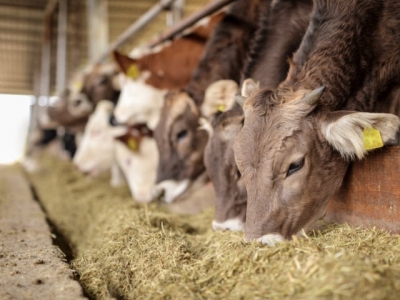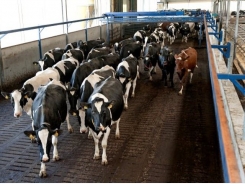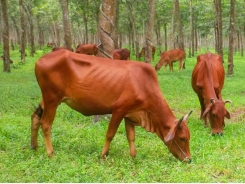Feed efficient cows may use less energy in the rumen epithelium

Cows considered more feed efficient, or that have a lower residual feed intake may use less energy in the ruminal tissue, say researchers.
Photo: GettyImages/ Ljupco
A team of researchers from Brazil, the US and UK examined the interaction between feed efficiency or residual feed intake (RFI) and the expression of genes in the rumen epithelium. The group published its work in the journal of Animal Feed Science and Technology.
“We hypothesized that low RFI animals would have lower rumen epithelium energy expenditures than those with high RFI,” said the researchers. “Therefore, the objective of this study was to evaluate the expression of genes involved in metabolism and transport in rumen epithelium of Nellore bulls classified as High, Medium, and Low RFI.”
They found that there was a reduction in the expression of genes related to the proteins used in the oxidative phosphorylation process in the rumen epithelium for more efficient bulls, those with lower or medium residual feed intake (RFI), when compared to bulls considered to have high RFI or that were less feed efficient.
“Our results may indicate a greater energy production and expenditure in the rumen epithelium of less efficient animals, contributing [to] their lower efficiency,” the researchers said.
However, more research is needed to identify the relationship between the production of energy and its distribution in epithelial tissue, they added.
1/ Why feed efficiency
Feed costs remain a major input in the production of beef cattle, said the researchers. There has been an increasing interest in breeding animals that are more efficient at converting feed into meat.
The residual feed intake (RFI) is the difference between expected feed intake, which is based on animals’ needs for body weight maintenance and production, and actual feed intake, they said.
“Efficient animals, with low RFI, consume less feed at the same level of production as inefficient (high RFI) animals."
The measurement of RFI is a type of feed efficiency that is considered “moderately heritable” and “independent of growth and maturity patterns,” they said.
RFI has been suggested as a trait for genetic selection to reduce feed inputs while maintaining growth performance.
“It has been speculated that differences in RFI could be associated with several biological processes involved in energy expenditure, suggesting that low RFI animals may have lower tissue energy requirements."
Rumen epithelium is a metabolically active tissue that has a high oxygen demand and mitochondrial concentration and which supports cell proliferation, contractions, transport and protective functions, said the researchers. But the cellular processes that take place in the tissue likely add to the energy requirements of the cow.
“Most of the cellular energy in the rumen epithelium is generated throughout oxidative phosphorylation by the formation of ATP as a result of the electrons transfer from reducing equivalents (NADH + H+) released from VFA [volatile fatty acids] (especially butyrate) metabolism,” they said. “Thus, understanding the interplay between the production and consumption of ATP by the rumen epithelium at a molecular level offers the opportunity to develop markers that may be used to improve feed efficiency in beef cattle.”
RFI variation may relate to differences in several factors including muscle metabolism, methane production, rumen microbial structure or hepatic metabolism, little is known about the role of biochemical mechanisms in the rumen epithelium, which could have a role to play in inter-animal difference, they said.
2/ Methods and materials
Before the feeding trial, 129 young bulls were followed for a growth period of 98 days on the same diet, the researcher said. The initial feed was designed to 1 kg/d of body weight gain and the RFI (kg/day) was determined after the growth period.
In the feeding trial 27 of the bulls were split into groups with low, medium and high RFI then given a finishing diet for a 103-day period, they said. “The finishing diet was composed of 333 g/kg corn silage, 17 g/kg brachiaria hay, 465 g/kg dry ground corn, 163 g/kg soybean meal, 6 g/kg urea, 4 g/kg ammonium sulfate, and 13 g/kg mineral mixture (dry matter basis), and were formulated to meet the requirements of 1.3 kg of daily gain with a target finish weight of 550 kg,” they added.
Bulls were harvested at the end of the period and ruminal fluid was collected for analysis, they said. Volatile fatty acid (VFA) amounts were checked as were RNA concentrations and presence of 26 target genes were examined.
Genes were checked based on their involvement with the rumen epithelium functional pathway, they said.
3/ Results
There were no differences found for concentrations of total VFA or the molar proportions of VFAs individually, the researchers said. Expression of genes linked to the transportation of ruminal VFA and urea also were similar among the groups of cattle.
However, the mRNA expression of two genes related to oxidative phosphorylation was found to vary among the RFI groups, they said. Less efficient cows had more UQCR10 and NDUFB4.
“Our data revealed a decreased mRNA expression of NDUFB4 and UQCR10, genes that encodes key proteins involved in oxidative phosphorylation process in rumen epithelium of Low and Medium compared to High RFI bulls,” they said. “Conversely, no differences were observed in mRNA expression of markers associated to other key biological process that would contribute for differences in feed efficiency.”
“These findings may indicate that more efficient animals (Low and Medium RFI) have lower energy expenditure in this tissue, which likely contributes for their better efficiency compared to the less efficient (High RFI) bulls,” they added.
Source: Animal Feed Science and Technology
Authors: P. Del Benedeti, E.Detmann, H. Mantovani, S. Bonilha, N. Serão, D. Lopes, W. Silva, C. Newbold, M. Duarte
Related news
Tools

Phối trộn thức ăn chăn nuôi

Pha dung dịch thủy canh

Định mức cho tôm ăn

Phối trộn phân bón NPK

Xác định tỷ lệ tôm sống

Chuyển đổi đơn vị phân bón

Xác định công suất sục khí

Chuyển đổi đơn vị tôm

Tính diện tích nhà kính

Tính thể tích ao




 How to select a top-performing beef cow
How to select a top-performing beef cow  Research Reveals Current Cattle Injections Increase Risk of…
Research Reveals Current Cattle Injections Increase Risk of…